Chapter 4. Fashion Forward
Style is knowing who you are,
what you want to say,
and not giving a damn.Orson Welles
While each of the areas we’ve explored still have room for improvement, their basic advantages and limitations are already known. The companies we spoke with are more or less pushing toward common goals and best practices in those areas. However, there are territories that remain relatively untested—and are therefore quite exciting.
Here, we briefly explore the merging of online and offline shopping, and how that affects data collection. We take a short look at the implications of data collection in wearable tech—truly a merging of fashion with big data. And finally, we make a note about the important privacy implications of these new technologies.
Online Meets Offline
The proliferation of in-store devices that can collect and share data is a topic that could fill its own report—but here we’ll simply mention it and encourage further exploration. As beacons of all types become less and less expensive—and as we start to understand the best ways to use them, they will become more and more widely adopted.
In-store data can go the other way as well: “smart fixtures,” such as interactive tables, connected mannequins, and tablet signage, can push data to a customer in a way that can make product information part of a brand’s story-telling experience.
Many retailers are turning to another hybrid model: temporary pop-up shops. Pop-up shops are a way for online retailers to experience some of the benefits of a physical presence, and the pop-up shops can provide data and analytic insights unavailable in an online-only experience.
Melissa Gonzalez, CEO of The Lionesque Group and an award-winning pop-up store producer, explains: “When a brand does a pop-up shop, they have a unique, isolated opportunity to collect both quantitative and qualitative data, data that can drive long-term ROI. It can affect manufacturing, merchandising, and marketing decisions in the future.” However, you have to be prepared, Gonzalez says. “In order to really capitalize on that benefit, brands need to have elements in place to track relevant data. Some are basic, like getting Google Analytics set up, and understanding where your drivers of traffic are coming from. It could be utilizing sites like tagboard.com, and creating a hashtag for your program, and then going back and seeing all the people who interacted with your brand. Or, it might be as simple as literally going back to your own social channels and seeing what new engagement happened and how many times you were mentioned over the time period of your pop-up.”
Whether it’s data collection, using data for storytelling, or both, the way that we’re using big data in stores is shifting quickly.
Wearables and Big Data
This is the place where fashion and big data literally overlap. As an increasing number of people wear an increasing number of data-collection devices—that are, in turn, collecting increasing types and amounts of data—we’ll start to see more and more discussion happening around the appropriate ways to collect, parse, store, and use that data.
From physical- and mental-health data, to location and identity information, wearable tech is often a promise made based on a device’s ability to collect data—and lots of it. All of the lessons that we’ve learned in big data (about helpfulness, privacy, and respect, to name just a few) will need to be continuously revisited in order to build a stable industry.
Privacy, Please
Of course, data usage is not all-or-nothing; there’s also the question of how much (and which) data to collect, and how to use it.
While Stitch Fix asks explicitly for some very personal data, including physical characteristics and lifestyle factors (like whether a customer is a mother and how many times per week she goes out), the company is very conscientious about asking only for data that actually goes into improving the service. “If we don’t use it, we’ll probably take it away,” says Colson. “If it doesn’t add any value, we’ll probably get rid of it so we don’t needlessly collect information.”
As another example—InSparq doesn’t have privacy issues because they don’t disclose any personal information, and the company’s results trend in aggregate. As Sonsev explains, “Privacy issues come up when you start using personal information without people’s permission, and disclose personally identifiable information (which we don’t even use).”
Physical attributes can feel personal as well—not many people would want their exact measurements made public. It is critical to remember that transparency regarding how consumer data is collected, shared, and stored is not merely a wise choice, but a government-regulated factor across industries. Around the world, government regulators generally require that any website that collects consumer data include a privacy policy that describes the company’s privacy and data security practices.
